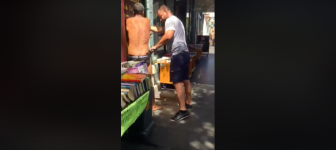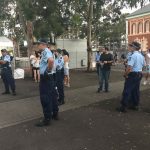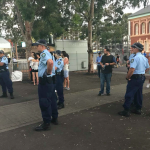Aboriginal Elder Strip Searched on Busy Sydney Road

The Law Enforcement Conduct Commission announced at the end of October that it was launching an investigation into the use of strip searches by NSW police. The inquiry is in response to growing allegations that officers are abusing their powers.
This was against a backdrop of a growing awareness that strip search use is increasing in this state. Figures released last July revealed that police have almost doubled the amount of strip searches they’re conducting following a positive indication from a drug detection dog.
Then NSW Greens MLC David Shoebridge released data late last month that shows over the last four years the NSW Police Force has increased its use of this invasive practice by 47 percent: up from 3,735 strip searches in 2014-15 to 5,483 in 2017-18.
There’s also been reports emerging of disturbing trends in the way these searches are being applied. Reports out of rural NSW reveal officers have been using this technique on Aboriginal children as young as 11. While other reports indicate police aren’t following the required protocol.
And now, Sydney Criminal Lawyers has seen footage that shows an illegal strip search being conducted in an inner city area. It involved an Aboriginal elder being forced to remove his clothes in broad daylight on the high street.
https://www.facebook.com/1719590536/videos/10205351082972775/
An abuse of power
When the footage begins the First Nations man is standing handcuffed in his underwear on Glebe Point Road, out the front of popular bookstores. Two plain clothes police officers – a man and a woman both of Anglo appearance – are standing before him.
This scene appears to be a clear breach of police strip search powers, which are set out in division 4 of the Law Enforcement (Powers and Responsibilities Act) 2002 (LEPRA). Section 33 of the legislation stipulates that a search must be carried out in a “private area”, not a public street.
The male officer is seen to push the detained man up against a wall. Then he grabbed at the shirt that was hanging from the man’s handcuffed hands, before he clearly breached the requirements of the law once again by running his fingers around the inside of the elastic of the man’s underwear.
Section 33 also provides that a strip search cannot involve “an examination of the body by touch”. In 2017, a Sydney man was acquitted of his drug possession conviction after it was found on appeal that the officers involved breached the strip search laws in both these ways.
This roadside search further contravened the requirements of this section of the LEPRA in two additional ways. Firstly, strip searches must never be carried out by member of the opposite sex, and one of the officers was a woman.
And a strip search must not be conducted in the presence or view of anyone not needed for the purposes of the search, which would amount to all the passersby in the immediate vicinity, when the search took place on 8 January.
Roughing up the detainee
The male police officer next ordered the handcuffed man to sit down. And after he refused, the officer attempted to force him to the ground. The plain clothes officer eventually grabbed at the detainee’s legs, swept them off the ground, and caused the man’s back to firmly hit the footpath.
After the man sat up cross-legged, the female officer hovered over him, while her male counterpart searched through the older Indigenous man’s shoes and shorts. The officer retrieved a box of syringes from the gutter and held them up, as he asked the man why he had them in his possession.
The individual filming can be heard to say that the syringes in question can be obtained from the hospital for free. Indeed, there are literally hundreds of needle and syringe program outlets across the state, which are sponsored by the NSW government.
Five minutes into the fifteen minute clip, the female officer allows the man to pull his shirt back over his head, so he then continues to stand on the side of the road with his torso covered, although he remains in his underwear.
The unwarranted detention continues
The person filming from their phone can be heard telling another onlooker that the police initially stopped the man who was walking down the road for no apparent reason, then handcuffed him and ordered him to remove his clothing.
The filming individual further tells the other onlooker that the male officer said that he was not worried about being filmed, before threatening to arrest her next. It’s perfectly legal to film police officers as long as they are in a public place and it doesn’t hinder them in the execution of their duty.
As the minutes moved on, the handcuffed man began to call out to the male officer who was now sitting in an unmarked car parked at the side of the road. He demanded that the handcuffs be removed stating that as he was not actually under arrest, there was no reason to keep him cuffed.
The other onlooker made her way over to the police car and inquired about the removal of the handcuffs. She then relayed to the detained man that the officer told her that he didn’t have the key to the cuffs, and they were waiting for a third officer to turn up, so they could unlock them.
The male officer then made his way over to the man and informed him he was being issued with a move-on order and he would have to leave the area once the cuffs were removed. The detained man responded by telling him to move away, as the officer had already “assaulted” him once.
Then a third plain clothes officer arrived on the scene, the handcuffs were removed, and the Aboriginal elder walked free.
Intergenerational trauma
“This is the way you’ve treated black fellas for hundreds of years,” the detained man yelled out to the male officer seated in the car at one point. “For years, you’ve been treating my people like this. This is genocide, mate.”
The long history of Europeans detaining and incarcerating First Nations peoples in this country is well-known these days. The violence of the Frontier Wars broke out soon after the British arrived and continued on into the first half of last century.
Thousands of Indigenous children were ripped from their families during the 70-odd years of the Stolen Generations, while at present, Indigenous kids are still being forcibly removed from their families at disproportionate rates.
And today, Aboriginal and Torres Strait Islander people are proportionally the most incarcerated people on earth. They account for 28 percent of the adult prison population in this country, but less than 3 percent of the overall populace.
“Are you aware of intergenerational trauma?” the other onlooker asked the female police officer prior to the arrival of the cuff key. “That’s what you’re doing by keeping him handcuffed. You’re triggering his trauma.”






